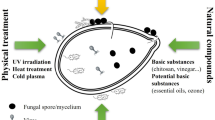Abstract
We evaluated the ability of fungicides to eradicate latent anthracnose infections and to protect young mango fruit from new infections in laboratory and field experiments in Thailand. Naturally inoculated developing fruits on the trees, 60 days after fruit set, were sprayed with 125 mg a.i./L. azoxystrobin, 125 mg a.i./L. difenoconazole, 500 mg a.i./L. carbendazim, 750 mg a.i./L. prochloraz, or 1050 mg a.i./L. propineb. All fungicides reduced the severity of subsequent postharvest anthracnose, although none of the treatments reduced disease incidence. Prochloraz was the most effective, reducing disease severity from 18.2 to 9.8% of the fruit surface area affected. Prochloraz also significantly reduced the development of postharvest symptoms on artificially inoculated developing fruit. Disease incidence on harvested fruits was further reduced if fungicide sprays were followed by fruit bagging, whether with new or once-used kraft paper bags with black-lined paper. Sprays of 300 mg a.i./L. of the defence primer Bion to sixty day-old developing fruit immediately before bagging also reduced subsequent anthracnose incidence to 47.5% and severity to 1.8% of fruit surface area, equivalent to prochloraz spray. Comparing postharvest dipping in prochloraz (250 mg a.i./L), azoxystrobin (250 mg a.i./L) or hot water (55 °C for 3 min), before storage at 15 °C for 10 days showed that hot water was the most effective postharvest treatment for mango fruits. From these results, the most effective management of anthracnose on mango fruit includes spraying developing fruit with prochloraz or Bion, followed by fruit bagging until harvest, and hot water dips of harvested fruit.






Similar content being viewed by others
References
Akem NC (2006) Mango anthracnose disease: present status and future research priorities. Plant Pathol J 5:266–273
Alemu K, Ayalew A, Woldefsadik K (2014) Effect of some medicinal plant in controlling anthracnose disease and improving postharvest quality of mango fruit. Persian Gulf Crop Protection 3(3):84–92
Arauz LF (2000) Mango anthracnose: economic impact and current options for integrated management. Plant Dis 84:600–611
Bargańska Ż, Ślebioda M, Namieśnik J (2014) Determination of pesticide residues in honeybees using modified QUEChERS sample work-up and liquid chromatography-tandem mass spectrometry. Molecules 19:2911–2924
Chonhenchob V, Kamhangwong D, Kruenate J, Khongrat K, Tangchantra N, Wichai U, Singh SP (2011) Preharvest bagging with wavelength-selective materials enhances development and quality of mango (Mangifera indica L.) cv. Nam Dok Mai #4. J Sci Food Agric 91:664–671
Chung WH, Chung WC, Peng MT, Yang HR, Huang JW (2010) Specific detection of benzimidazole resistance in Colletotrichum gloeosporioides from fruit crops by PCR-RFL. New Biotechnol 27:17–24
Codex Alimentarius (2014) Pesticide residues in food and feed. Pesticide index. http://www.codexalimentarius.net/pestres/data/pesticides/details.html?id = 229 Accessed 21 February 2015
Diedhiou PM, Diallo Y, Faye R, Mbengue AA, Sene A (2014) Efficacy of different fungicides against mango anthracnose in Senegalese soudanian agroclimate. Am J Plant Sci 5:2224–2229
Dinh SQ (2002) Postharvest loss of mango due to anthracnose and its infection biology and resistance of mango to the disease. M.S. thesis, Kasetsart University, Bangkok, Thailand
Estrada AB, Jeffries P, Dodd JC (1996) Field evaluation of a predictive model to control anthracnose disease of mango in the Philippines. Plant Pathol 45:294–301
FAOSTAT (2014) Production; Food and Agricultural commodities production. http://faostat.fao.org/site/339/default.aspx. Accessed 21 February 2015
FRAC (2014) FRAC Code List©. http://www.frac.info/. Accessed 21 Febuary 2015
Hofman PJ, Smith LG, Joyce DC, Johnson GI, Meiburg GF (1997) Bagging of mango (Mangifera indica cv. ‘Keitt’) fruit influences fruit quality and mineral composition. Postharvest Biol Technol 12:83–91
Joyce DC, Beasley DR, Shorter AJ (1997) Effect of pre-harvest bagging on fruit calcium levels and storage and ripening characteristics of ‘sensation’ mangoes. Aust J Exp Agric 37:383–389
Kitagawa H, Manabe K, Esguerra EB (1992) Bagging of fruit on the tree to control disease. Acta Hortic 321:870–875
Oanh LTK, Korpraditskul V, Rattanakreetakul C, Wasee S (2006) Influence of biotic and chemical plant inducers on resistance of chilli to anthracnose. Kasetsart J (Nat Sci) 40:39–48
Prusky D, Kobiler I, Miyara I, Alkan N (2009) Fruit disease. In: Litz RE (ed) The mango: botany, production and uses, 2nd edn. CAB International, Oxon, pp. 210–219
Sharma RR, Reddy SVR, Jhaleger MJ (2014) Pre-harvest fruit bagging: a useful approach for plant protection and improved post-harvest fruit quality. J Hortic Sci Biotechnol 89:101–113
Sivakumar D, Jiang Y, Yahia EM (2011) Maintaining mango (Mangifera indica L.) fruit quality during the export chain. Food Res Int 44:1254–1263
Sundravadana S, Alice D, Kuttalam S, Samiyappan R (2007) Efficacy of azoxystrobin on Colletotrichum gloeosporiodes Penz growth and on controlling mango anthracnose. J Agri Biol Sci 2:10–15
Swart SH, Swart G, Labuschagne C (2009) The effect of strategically timed pre-harvest fungicide applications on post-harvest decay of mango. VIIIthInt. Mango symposium. Acta Hortic 820:511–519
Tally A, Oostendor M, Lawton K, Staub T, Bassi B (1999) Commercial development of elicitors of induced resistance to pathogens. In: Anurag AA, Tuzun S, Bent E (eds) Induced plant defences against pathogens and herbivores. APS press, Minnesota, pp. 357–369
Thailand Office of Agricultural Economic (2013) Export. http://www.oae.go.th/oae_report/export_import/export.php. Accessed15July 2014
Vinggaard AM, Hass U, Dalgaard M, Andersen HR, Jørgensen EB, Christiansen S, Laier P, Poulsen ME (2006) Prochloraz: an imidazole fungicide with multiple mechanisms of action. Int J Androl 29:186–192
Acknowledgments
This work was financially supported by the Thailand Research Fund (TRF) through the Royal Golden Jubilee (RGJ) Ph.D. program (Grant No. PHD/0214/2552). We thanks the Department of Plant Pathology, Kasetsart University for the facilities and Mr. Somkeat Kitjareanchai and Mr. Sinchai Trakuantip, owners of the mango orchard and Dr. Chadyl Nimnual, managing director of Excel fruits Co. Ltd. for providing mango fruits in this research. Special thanks to Dr. Henik Sukorini and and Dr. Amanda Eiden for proofreading this manuscript.
Author information
Authors and Affiliations
Corresponding author
Rights and permissions
About this article
Cite this article
Chiangsin, R., Wanichkul, K., Guest, D.I. et al. Reduction of anthracnose on ripened mango fruits by chemicals, fruit bagging, and postharvest treatments. Australasian Plant Pathol. 45, 629–635 (2016). https://doi.org/10.1007/s13313-016-0456-x
Received:
Accepted:
Published:
Issue Date:
DOI: https://doi.org/10.1007/s13313-016-0456-x




